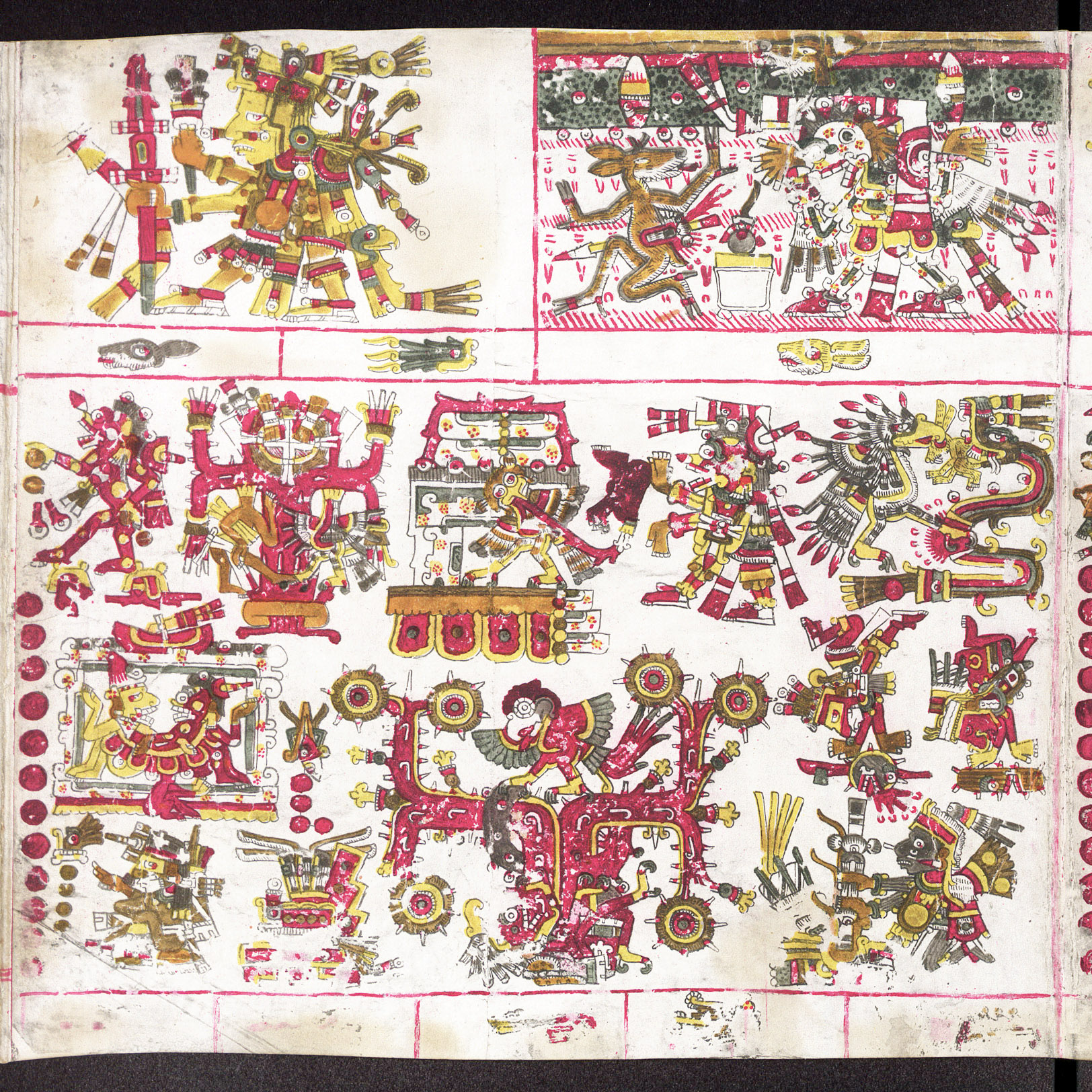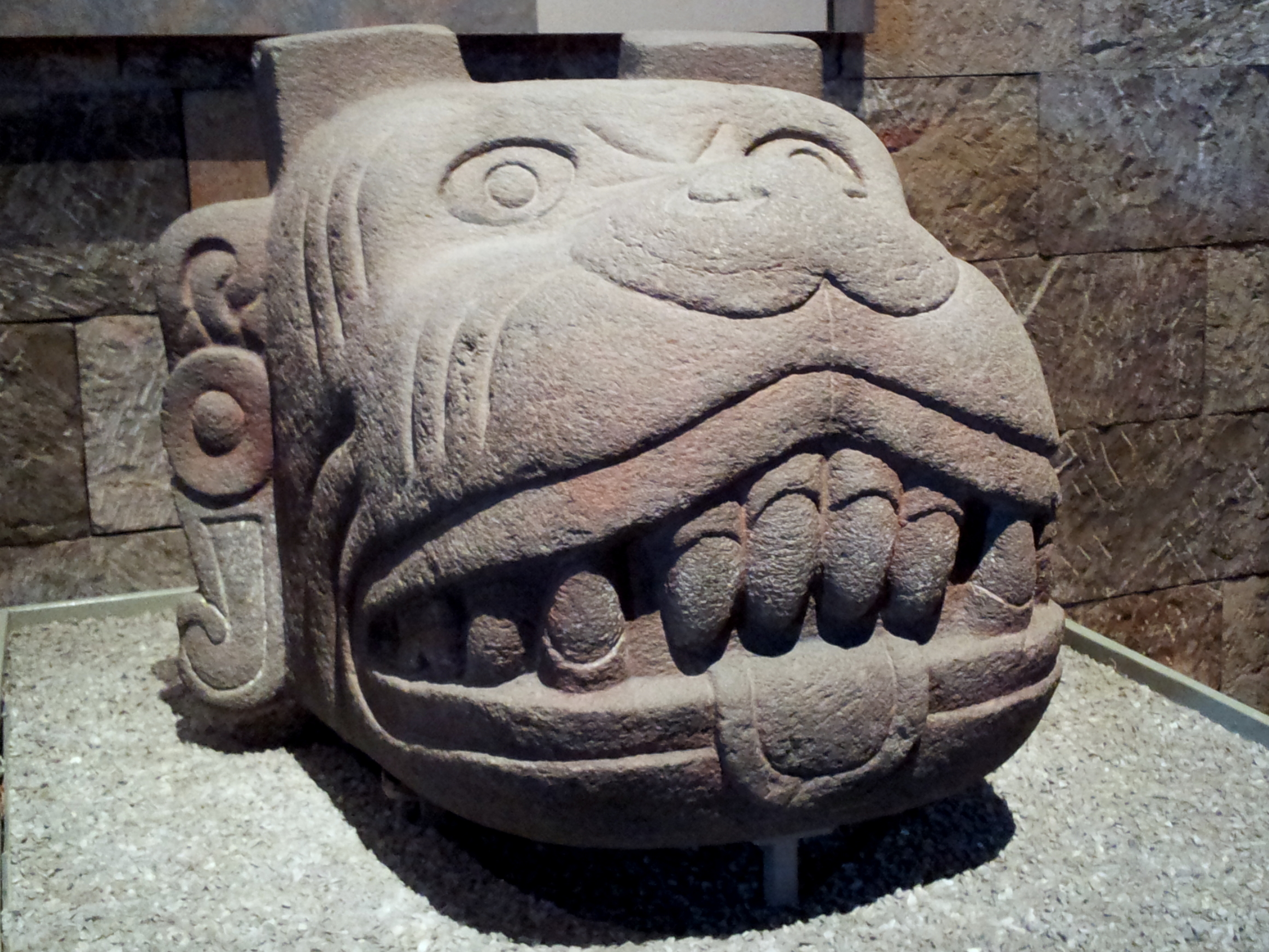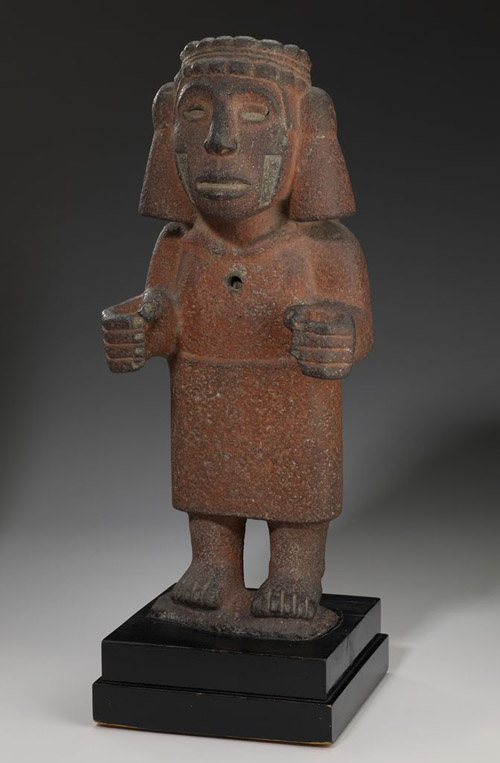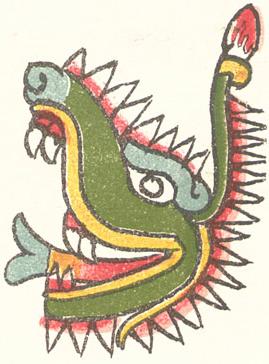|
Mictlān
Mictlan () is the underworld of Aztec mythology. Most people who die would travel to Mictlan, although other possibilities exist. (see " Other destinations", below). Mictlan consists of nine distinct levels. The journey from the first level to the ninth is difficult and takes four years, but the dead are aided by the psychopomp, Xolotl. The dead must pass many challenges, such as crossing a mountain range where the mountains crash into each other, a field with wind that blows flesh-scraping knives, and a river of blood with fearsome jaguars. Mictlan also features in the Aztec creation myth. Mictlantecuhtli set a pit to trap Quetzalcoatl. When Quetzalcoatl entered Mictlan seeking bones with which to create humans, Mictlantecuhtli was waiting. He asked Quetzalcoatl to travel around Mictlan four times blowing a conch shell with no holes. Quetzalcoatl eventually put some bees in the conch shell to make sound. Fooled, Mictlantecuhtli showed Quetzalcoatl to the bones. But Quetzalcoa ... [...More Info...] [...Related Items...] OR: [Wikipedia] [Google] [Baidu] |
Xolotl
In Aztec mythology, Xolotl () was a god of fire and lightning. He was commonly depicted as a dog-headed man and was a soul-guide for the dead. He was also god of twins, monsters, misfortune, sickness, and deformities. Xolotl is the canine brother and twin of Quetzalcoatl, the pair being sons of the virgin Chimalma. He is the dark personification of Venus, the evening star, and was associated with heavenly fire. The Axolotl is named after him. Myths and functions Xolotl was the sinister god of monstrosities who wears the spirally-twisted wind jewel and the ear ornaments of Quetzalcoatl. His job was to protect the sun from the dangers of the underworld. As a double of Quetzalcoatl, he carries his conch-like ehecailacacozcatl or wind jewel. Xolotl accompanied Quetzalcoatl to Mictlan, the land of the dead, or the underworld, to retrieve the bones from those who inhabited the previous world (Nahui Atl) to create new life for the present world, Nahui Ollin, the sun of movement ... [...More Info...] [...Related Items...] OR: [Wikipedia] [Google] [Baidu] |
Underworld
The underworld, also known as the netherworld or hell, is the supernatural world of the dead in various religious traditions and myths, located below the world of the living. Chthonic is the technical adjective for things of the underworld. The concept of an underworld is found in almost every civilization and "may be as old as humanity itself". Common features of underworld myths are accounts of living people making journeys to the underworld, often for some heroic purpose. Other myths reinforce traditions that entrance of souls to the underworld requires a proper observation of ceremony, such as the ancient Greek story of the recently dead Patroclus haunting Achilles until his body could be properly buried for this purpose. Persons having social status were dressed and equipped in order to better navigate the underworld. A number of mythologies incorporate the concept of the soul of the deceased making its own journey to the underworld, with the dead needing to be taken a ... [...More Info...] [...Related Items...] OR: [Wikipedia] [Google] [Baidu] |
Xipe Totec
In Aztec mythology and religion, Xipe Totec (; nci-IPA, Xīpe Totēc, ˈʃiːpe ˈtoteːk(ʷ)) or Xipetotec ("Our Lord the Flayed One") was a life-death-rebirth deity, god of agriculture, vegetation, the east, spring, goldsmiths, silversmiths, liberation, and the seasons. Xipe Totec was also known by various other names, including Tlatlauhca (), Tlatlauhqui Tezcatlipoca () ("Red Smoking Mirror") and Yohuallahuan () ("the Night Drinker"), and Yaotzin ("revered enemy"). The Tlaxcaltecs and the Huexotzincas worshipped a version of the deity under the name of Camaxtli, and the god has been identified with Yopi, a Zapotec god represented on Classic Period urns.Miller & Taube 1993, 2003, p.188. The female equivalent of Xipe Totec was the goddess Xilonen- Chicomecoatl. Xipe Totec connected agricultural renewal with warfare. He flayed himself to give food to humanity, symbolic of the way maize seeds lose their outer layer before germination and of snakes shedding their skin. He is o ... [...More Info...] [...Related Items...] OR: [Wikipedia] [Google] [Baidu] |
Tlaltecuhtli
Tlaltecuhtli (Classical Nahuatl ''Tlāltēuctli'', ) is a pre-Columbian Mesoamerican deity worshipped primarily by the Mexica (Aztec) people. Sometimes referred to as the "earth monster," Tlaltecuhtli's dismembered body was the basis for the world in the Aztec creation story of the fifth and final cosmos. In carvings, Tlaltecuhtli is often depicted as an anthropomorphic being with splayed arms and legs. Considered the source of all living things, she had to be kept sated by human sacrifices which would ensure the continued order of the world. According to a source, in the creation of the Earth, the gods did not tire of admiring the liquid world, no oscillations, no movements, so Tezcatlipoca and Quetzalcoatl thought that the newly created world should be inhabited. And for this, they made Tlalcihuatl, 'Lady of the earth', come down from heaven, and Tlaltecuhtli, 'Lord of the earth', would be her consort. Tezcatlipoca and Quetzalcoatl create the Earth from the body of Cipactli, a ... [...More Info...] [...Related Items...] OR: [Wikipedia] [Google] [Baidu] |
Chalchiuhtlicue
Chalchiuhtlicue (from ''chālchihuitl'' "jade" and ''cuēitl'' "skirt") (also spelled Chalciuhtlicue, Chalchiuhcueye, or Chalcihuitlicue) ("She of the Jade Skirt") is an Aztec deity of water, rivers, seas, streams, storms, and baptism. Chalchiuhtlicue is associated with fertility, and she is the patroness of childbirth. Chalchiuhtlicue was highly revered in Aztec culture at the time of the Spanish conquest, and she was an important deity figure in the Postclassic Aztec realm of central Mexico. Chalchiuhtlicue belongs to a larger group of Aztec rain gods, and she is closely related to another Aztec water god called Chalchiuhtlatonal. Religious significance Chalchiuitlicue directly translates to "Jade her skirt"; however, her name is most commonly interpreted as "she of the jade skirt." She was also known as Chalchiuhtlatonac (chalchihu tltla-tona-c) "She who shines like jade" and Matlalcueye "Possessor of the Blue Skirt" by the Tlaxcalans, an indigenous group who inhabited the ... [...More Info...] [...Related Items...] OR: [Wikipedia] [Google] [Baidu] |
Cipactli
Cipactli ( nci, Cipactli "crocodile" or "caiman") was the first day of the Aztec divinatory count of 13 X 20 days (the '' tonalpohualli'') and ''Cipactonal'' "Sign of Cipactli" was considered to have been the first diviner. In Aztec cosmology, the crocodile symbolized the earth floating in the primeval waters. According to one Aztec tradition, ''Teocipactli'' "Divine Crocodile" was the name of a survivor of the flood who rescued himself in a canoe and again repopulated the earth. In the Mixtec Vienna Codex (Codex Vindobonensis Mexicanus I), Crocodile is a day associated with dynastic beginnings. In Aztec mythology, Cipactli was a primeval sea monster, part crocodilian, part fish, and part toad or frog, with indefinite gender. Always hungry, every joint on its body was adorned with an extra mouth. The deity Tezcatlipoca sacrificed a foot when he used it as bait to draw the monster nearer. He and Quetzalcoatl created the earth from its body. Karl A. Taube has noted that among the F ... [...More Info...] [...Related Items...] OR: [Wikipedia] [Google] [Baidu] |
Underworld
The underworld, also known as the netherworld or hell, is the supernatural world of the dead in various religious traditions and myths, located below the world of the living. Chthonic is the technical adjective for things of the underworld. The concept of an underworld is found in almost every civilization and "may be as old as humanity itself". Common features of underworld myths are accounts of living people making journeys to the underworld, often for some heroic purpose. Other myths reinforce traditions that entrance of souls to the underworld requires a proper observation of ceremony, such as the ancient Greek story of the recently dead Patroclus haunting Achilles until his body could be properly buried for this purpose. Persons having social status were dressed and equipped in order to better navigate the underworld. A number of mythologies incorporate the concept of the soul of the deceased making its own journey to the underworld, with the dead needing to be taken a ... [...More Info...] [...Related Items...] OR: [Wikipedia] [Google] [Baidu] |
Ashvattha
According to Hindu scriptures, Aśvattha, ( sa, अश्वत्थ) or ''Sacred fig'' (''Ficus religiosa''), is a sacred tree for the Hindus and has been extensively mentioned in texts pertaining to Hinduism, for example as ''peepul'' in Rig Veda mantra I.164.20. In Buddhism, the Bodhi Tree under which Gautama Buddha gained enlightenment is also of the same species. Adi Shankara derives it from shva (tomorrow) and stha (that which remains). Ashva (horse) and stha (situated), meaning where horses are tied, is another derivation. Yama, while instructing Naciketa describes the eternal Asvattha tree with its root upwards, and branches downwards, which is the pure immortal Brahman, in which all these worlds are situated, and beyond which there is nothing else (Katha Upanishad Verse II.iii.1). Meanwhile, Krishna tells us that the Asvattha tree having neither end nor beginning nor stationariness whatsoever has its roots upwards and branches downwards whose branches are nourished by t ... [...More Info...] [...Related Items...] OR: [Wikipedia] [Google] [Baidu] |
Yggdrasil
Yggdrasil (from Old Norse ), in Norse cosmology, is an immense and central sacred tree. Around it exists all else, including the Nine Worlds. Yggdrasil is attested in the ''Poetic Edda'' compiled in the 13th century from earlier traditional sources, and in the ''Prose Edda'' compiled in the 13th century by Snorri Sturluson. In both sources, Yggdrasil is an immense ash tree that is central to the cosmos and considered very holy. The gods go to Yggdrasil daily to assemble at their traditional governing assemblies, called things. The branches of Yggdrasil extend far into the heavens, and the tree is supported by three roots that extend far away into other locations; one to the well Urðarbrunnr in the heavens, one to the spring Hvergelmir, and another to the well Mímisbrunnr. Creatures live within Yggdrasil, including the dragon Níðhöggr, an unnamed eagle, and the stags Dáinn, Dvalinn, Duneyrr and Duraþrór. Scholars generally consider ''Hoddmímis holt'', ''Mímameiðr'' ... [...More Info...] [...Related Items...] OR: [Wikipedia] [Google] [Baidu] |
World Tree
The world tree is a motif present in several religions and mythologies, particularly Indo-European religions, Siberian religions, and Native American religions. The world tree is represented as a colossal tree which supports the heavens, thereby connecting the heavens, the terrestrial world, and, through its roots, the underworld. It may also be strongly connected to the motif of the tree of life, but it is the source of wisdom of the ages. Specific world trees include '' égig érő fa'' in Hungarian mythology, Ağaç Ana in Turkic mythology, Andndayin Ca˙r in Armenian mythology, Modun in Mongol mythology, ''Yggdrasil'' in Norse mythology, Irminsul in Germanic mythology, the oak in Slavic, Finnish and Baltic, Iroko in Yoruba religion, ''Jianmu'' in Chinese mythology, and in Hindu mythology the ''Ashvattha'' (a ''Ficus religiosa''). General description Scholarship states that many Eurasian mythologies share the motif of the "world tree", "cosmic tree", or "Eagle and Serpe ... [...More Info...] [...Related Items...] OR: [Wikipedia] [Google] [Baidu] |









